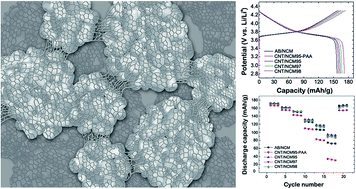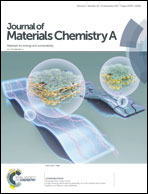Three-dimensional electric micro-grid networks for high-energy-density lithium-ion battery cathodes†
Abstract
High-energy-density LiNi0.5Co0.2Mn0.3O2 (NCM523) cathodes are prepared by the reduction of carbon additive loading based on the self-organization of water-soluble multiwalled carbon nanotubes (MW-CNTs) into MW-CNT/NCM523 supramolecular assemblies. Field emission scanning electron microscopy reveals that the MW-CNTs homogeneously included NCM523 particles and formed a grid structure that bridges the NCM523 particles. These structural characteristics are quite different from those of conventional composite electrode systems in lithium-ion secondary batteries. The supramolecular assemblies enable the increase of the NCM523 particle concentration (up to 98 wt%) and tap density (up to 3.8 g cm−3), and eliminate the need for a binder. A higher C-rate capability and cyclability are achieved by improving the kinetic parameters of the composite electrode for the battery reactions. In particular, the maximum average discharge capacity based on the total mass of the composite is 171 mA h g−1 in the MW-CNT/NCM523 (98 wt%) composite electrode within the cut-off voltage range of 2.5–4.3 V (vs. Li+/Li), which is much higher than those of conventional acetylene black systems (157 mA h g−1).



 Please wait while we load your content...
Please wait while we load your content...